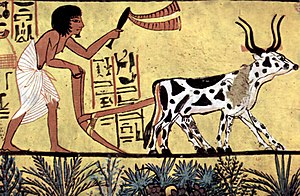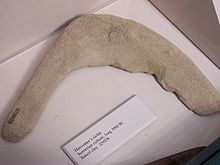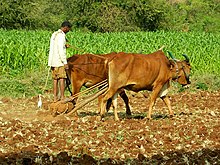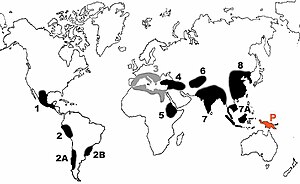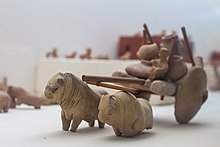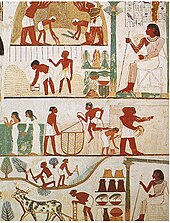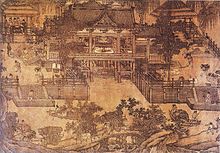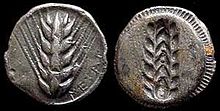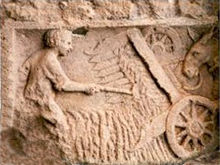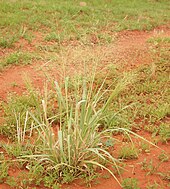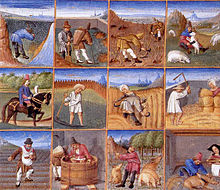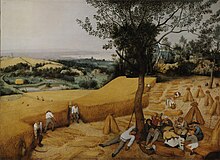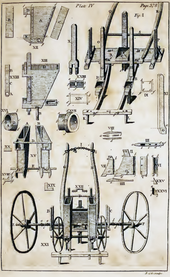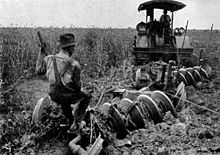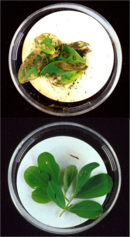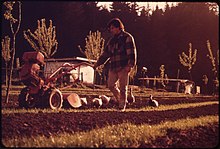Ploughing with a yoke of horned cattle in Ancient Egypt. Painting from the burial chamber of Sennedjem, c. 1200 BC.
The history of agriculture records the domestication of plants and animals and the development and dissemination of techniques for raising them productively. Agriculture began independently in different parts of the globe, and included a diverse range of taxa. At least eleven separate regions of the Old and New World were involved as independent centers of origin.
Wild grains were collected and eaten from at least 20,000 BC. From around 9500 BC, the eight Neolithic founder crops – emmer wheat, einkorn wheat, hulled barley, peas, lentils, bitter vetch, chick peas, and flax – were cultivated in the Levant. Rye may have been cultivated earlier but this remains controversial. Rice was domesticated in China by 6200 BC with earliest known cultivation from 5700 BC, followed by mung, soy and azuki beans. Pigs were domesticated in Mesopotamia around 11,000 BC, followed by sheep between 11,000 BC and 9000 BC. Cattle were domesticated from the wild aurochs in the areas of modern Turkey and Pakistan around 8500 BC. Sugarcane and some root vegetables were domesticated in New Guinea around 7000 BC. Sorghum was domesticated in the Sahel region of Africa by 5000 BC. In the Andes of South America, the potato was domesticated between 8000 BC and 5000 BC, along with beans, coca, llamas, alpacas, and guinea pigs. Bananas were cultivated and hybridized in the same period in Papua New Guinea. In Mesoamerica, wild teosinte was domesticated to maize by 4000 BC. Cotton was domesticated in Peru by 3600 BC. Camels were domesticated late, perhaps around 3000 BC.
The Bronze Age, from c. 3300 BC, witnessed the intensification of agriculture in civilizations such as Mesopotamian Sumer, ancient Egypt, the Indus Valley Civilisation of South Asia, ancient China, and ancient Greece. During the Iron Age and era of classical antiquity, the expansion of ancient Rome, both the Republic and then the Empire, throughout the ancient Mediterranean and Western Europe built upon existing systems of agriculture while also establishing the manorial system that became a bedrock of medieval agriculture. In the Middle Ages, both in the Islamic world
and in Europe, agriculture was transformed with improved techniques and
the diffusion of crop plants, including the introduction of sugar,
rice, cotton and fruit trees such as the orange to Europe by way of Al-Andalus. After the voyages of Christopher Columbus in 1492, the Columbian exchange brought New World crops such as maize, potatoes, sweet potatoes, and manioc to Europe, and Old World crops such as wheat, barley, rice, and turnips, and livestock including horses, cattle, sheep, and goats to the Americas.
Irrigation, crop rotation, and fertilizers were introduced soon after the Neolithic Revolution and developed much further in the past 200 years, starting with the British Agricultural Revolution.
Since 1900, agriculture in the developed nations, and to a lesser
extent in the developing world, has seen large rises in productivity as
human labour has been replaced by mechanization, and assisted by synthetic fertilizers, pesticides, and selective breeding. The Haber-Bosch process allowed the synthesis of ammonium nitrate fertilizer on an industrial scale, greatly increasing crop yields. Modern agriculture has raised social, political, and environmental issues including water pollution, biofuels, genetically modified organisms, tariffs and farm subsidies. In response, organic farming developed in the twentieth century as an alternative to the use of synthetic pesticides.
Origins
Origin hypotheses
Indigenous Australian camp by Skinner Prout, 1876
Scholars have developed a number of hypotheses to explain the historical origins of agriculture. Studies of the transition from hunter-gatherer to agricultural societies indicate an antecedent period of intensification and increasing sedentism; examples are the Natufian culture in the Levant,
and the Early Chinese Neolithic in China. Current models indicate that
wild stands that had been harvested previously started to be planted,
but were not immediately domesticated.
Localized climate change is the favored explanation for the origins of agriculture in the Levant. When major climate change took place after the last ice age (c. 11,000 BC), much of the earth became subject to long dry seasons. These conditions favored annual plants which die off in the long dry season, leaving a dormant seed or tuber. An abundance of readily storable wild grains and pulses enabled hunter-gatherers in some areas to form the first settled villages at this time.
Early development
Sumerian harvester's sickle, 3000 BC, made from baked clay
Early people began altering communities of flora and fauna for their own benefit through means such as fire-stick farming and forest gardening very early.
Exact dates are hard to determine, as people collected and ate seeds
before domesticating them, and plant characteristics may have changed
during this period without human selection. An example is the semi-tough
rachis and larger seeds of cereals from just after the Younger Dryas (about 9500 BC) in the early Holocene in the Levant region of the Fertile Crescent. Monophyletic characteristics were attained without any human intervention, implying that apparent domestication of the cereal rachis could have occurred quite naturally.
An Indian farmer with a rock-weighted scratch plough pulled by two oxen. Similar ploughs were used throughout antiquity.
Agriculture began independently in different parts of the globe, and
included a diverse range of taxa. At least 11 separate regions of the
Old and New World were involved as independent centers of origin. Some of the earliest known domestications were of animals. Domestic pigs had multiple centres of origin in Eurasia, including Europe, East Asia and Southwest Asia, where wild boar were first domesticated about 10,500 years ago. Sheep were domesticated in Mesopotamia between 11,000 BC and 9000 BC. Cattle were domesticated from the wild aurochs in the areas of modern Turkey and Pakistan around 8500 BC. Camels were domesticated late, perhaps around 3000 BC.
Centers of origin identified by Nikolai Vavilov in the 1930s. Area 3 (grey) is no longer recognized as a centre of origin, and Papua New Guinea (red, 'P') was identified more recently.
It was not until after 9500 BC that the eight so-called founder crops of agriculture appear: first emmer and einkorn wheat, then hulled barley, peas, lentils, bitter vetch, chick peas and flax. These eight crops occur more or less simultaneously on Pre-Pottery Neolithic B (PPNB) sites in the Levant, although wheat was the first to be grown and harvested on a significant scale. At around the same time (9400 BC), parthenocarpic fig trees were domesticated.
Domesticated rye occurs in small quantities at some Neolithic sites in (Asia Minor) Turkey, such as the Pre-Pottery Neolithic B (c. 7600 – c. 6000 BC) Can Hasan III near Çatalhöyük, but is otherwise absent until the Bronze Age of central Europe, c. 1800–1500 BC. Claims of much earlier cultivation of rye, at the Epipalaeolithic site of Tell Abu Hureyra in the Euphrates valley of northern Syria remain controversial. Critics point to inconsistencies in the radiocarbon dates, and identifications based solely on grain, rather than on chaff.
By 7000 BC, the Sumerians systematized and scaled up sowing and harvesting in Mesopotamia's fertile soil. By 8000 BC, farming was entrenched on the banks of the Nile.
About this time, agriculture was developed independently in the Far
East, probably in China, with rice rather than wheat as the primary
crop. Maize was domesticated from the wild grass teosinte in West Mexico by 6700 BC.
The potato (8000 BC), tomato, pepper (4000 BC), squash (8000 BC) and several varieties of bean (8000 BC onwards) were domesticated in the New World.
Agriculture was independently developed on the island of New Guinea.
Banana cultivation of Musa acuminata, including hybridization, dates back to 5000 BC, and possibly to 8000 BC, in Papua New Guinea.
Bees were kept for honey in the Middle East around 7000 BC. Archaeological evidence from various sites on the Iberian peninsula suggest the domestication of plants and animals between 6,000 and 4500 BC. Céide Fields in Ireland,
consisting of extensive tracts of land enclosed by stone walls, date to
3500 BC and are the oldest known field systems in the world. The horse was domesticated in the Pontic steppe around 4000 BC. In Siberia, Cannabis
was in use in China in Neolithic times and may have been domesticated
there; it was in use both as a fibre for ropemaking and as a medicine in
Ancient Egypt by about 2350 BC.
Clay and wood model of a bull cart carrying farm produce in large pots, Mohenjo-daro. The site was abandoned in the 19th century BC.
In northern China, millet was domesticated by early Sino-Tibetan speakers at around 8,000 to 6,000 BC, becoming the main crop of the Yellow River basin by 5,500 BC. They were followed by mung, soy and azuki beans.
Chronological dispersal of Austronesian peoples across the Indo-Pacific
In southern China, rice was domesticated in the Yangtze River basin at around 11,500 to 6,200 BC, along with the development of wetland agriculture, by early Austronesian and Hmong-Mien-speakers. Other food plants were also harvested, including acorns, water chestnuts, and foxnuts. Rice cultivation was later spread to Island Southeast Asia by the Austronesian expansion,
starting at around 3,500 to 2,000 BC. This migration event also saw the
introduction of cultivated and domesticated food plants from Taiwan, Island Southeast Asia, and New Guinea into the Pacific Islands as canoe plants. Contact with Sri Lanka and Southern India by Austronesian sailors also led to an exchange of food plants which later became the origin of the valuable spice trade. In the 1st millennium AD, Austronesian sailors also settled Madagascar and the Comoros, bringing Southeast Asian and South Asian food plants with them to the East African coast, including bananas and rice. Rice was also spread southwards into Mainland Southeast Asia by around 2,000 to 1,500 BC by the migrations of the early Austroasiatic and Kra-Dai-speakers.
In the Sahel region of Africa, local rice and sorghum were domesticated by 5000 BC. Kola nut and coffee were domesticated in Africa. In New Guinea, ancient Papuan peoples began practicing agriculture around 7000 BC, domesticating sugarcane and taro. In the Indus Valley from the eighth millennium BC onwards at Mehrgarh,
2-row and 6-row barley were cultivated, along with einkorn, emmer, and
durum wheats, and dates. In the earliest levels of Merhgarh, wild game
such as gazelle, swamp deer, blackbuck, chital, wild ass, wild goat, wild sheep, boar, and nilgai were all hunted for food. These are successively replaced by domesticated sheep, goats, and humped zebu cattle by the fifth millennium BC, indicating the gradual transition from hunting and gathering to agriculture.
Maize and squash were domesticated in Mesoamerica; potato in South America, and sunflower in the Eastern Woodlands of North America.
Civilizations
Sumer
Domesticated animals on a Sumerian cylinder seal. 2500 BC.
Ancient Egypt
The civilization of Ancient Egypt was indebted to the Nile River
and its dependable seasonal flooding. The river's predictability and
the fertile soil allowed the Egyptians to build an empire on the basis
of great agricultural wealth. Egyptians were among the first peoples to
practice agriculture on a large scale, starting in the pre-dynastic
period from the end of the Paleolithic into the Neolithic, between
around 10,000 BC and 4000 BC. This was made possible with the development of basin irrigation. Their staple food crops were grains such as wheat and barley, alongside industrial crops such as flax and papyrus.
Indus valley
Jujube was domesticated in the Indian subcontinent by 9000 BC. Barley and wheat cultivation – along with the domestication of cattle, primarily sheep and goats – followed in Mehrgarh culture by 8000–6000 BC. This period also saw the first domestication of the elephant. Pastoral farming in India included threshing, planting crops in rows – either of two or of six – and storing grain in granaries. Cotton was cultivated by the 5th–4th millennium BC. By the 5th millennium BC, agricultural communities became widespread in Kashmir. Irrigation was developed in the Indus Valley Civilization by around 4500 BC.
The size and prosperity of the Indus civilization grew as a result of
this innovation, leading to more thoroughly planned settlements which
used drainage and sewers. Archeological evidence of an animal-drawn plough dates back to 2500 BC in the Indus Valley Civilization.
Ancient China
Ancient rice terraces in Yuanyang County, Yunnan
Records from the Warring States, Qin Dynasty, and Han Dynasty provide a picture of early Chinese agriculture from the 5th century BC to 2nd century AD which included a nationwide granary system and widespread use of sericulture. An important early Chinese book on agriculture is the Qimin Yaoshu of AD 535, written by Jia Sixie.
Jia's writing style was straightforward and lucid relative to the
elaborate and allusive writing typical of the time. Jia's book was also
very long, with over one hundred thousand written Chinese characters, and it quoted many other Chinese books that were written previously, but no longer survive.
The contents of Jia's 6th century book include sections on land
preparation, seeding, cultivation, orchard management, forestry, and
animal husbandry. The book also includes peripherally related content
covering trade and culinary uses for crops. The work and the style in which it was written proved influential on later Chinese agronomists, such as Wang Zhen and his groundbreaking Nong Shu of 1313.
A Northern Song era (960–1127 AD) Chinese watermill for dehusking grain with a horizontal waterwheel
For agricultural purposes, the Chinese had innovated the hydraulic-powered trip hammer by the 1st century BC.
Although it found other purposes, its main function to pound,
decorticate, and polish grain that otherwise would have been done
manually. The Chinese also began using the square-pallet chain pump by the 1st century AD, powered by a waterwheel or oxen pulling an on a system of mechanical wheels. Although the chain pump found use in public works of providing water for urban and palatial pipe systems, it was used largely to lift water from a lower to higher elevation in filling irrigation canals and channels for farmland. By the end of the Han dynasty in the late 2nd century, heavy ploughs had been developed with iron plough shares and mouldboards. These slowly spread west, revolutionizing farming in Northern Europe by the 10th century. (Thomas Glick,
however, argues for a development of the Chinese plough as late as the
9th century, implying its spread east from similar designs known in
Italy by the 7th century.)
Asian rice was domesticated 8,200–13,500 years ago in China, with a single genetic origin from the wild rice Oryza rufipogon, in the Pearl River valley region of China. Rice cultivation then spread to South and Southeast Asia.
Ancient Greece and Hellenistic world
An ear of barley, symbol of wealth in the city of Metapontum in Magna Graecia (i.e. the Greek colonies of southern Italy), stamped stater, c. 530–510 BCE
The major cereal crops of the ancient Mediterranean region were wheat, emmer, and barley, while common vegetables included peas, beans, fava,
and olives, dairy products came mostly from sheep and goats, and meat,
which was consumed on rare occasion for most people, usually consisted
of pork, beef, and lamb. Agriculture in ancient Greece was hindered by the topography of mainland Greece that only allowed for roughly 10% of the land to be cultivated properly, necessitating the specialized exportation of oil and wine and importation of grains from Thrace (centered in what is now Bulgaria) and the Greek colonies of southern Russia. During the Hellenistic period, the Ptolemaic Empire controlled Egypt, Cyprus, Phoenicia, and Cyrenaica, major grain-producing regions that mainland Greeks depended on for subsistence, while the Ptolemaic grain market also played a critical role in the rise of the Roman Republic. In the Seleucid Empire, Mesopotamia was a crucial area for the production of wheat, while nomadic animal husbandry was also practiced in other parts.
Roman Empire
Roman harvesting machine, a vallus, from a Roman wall in Belgium, which was then part of the province of Gallia Belgica
In the Greco-Roman world of Classical antiquity, Roman agriculture
was built on techniques originally pioneered by the Sumerians,
transmitted to them by subsequent cultures, with a specific emphasis on
the cultivation of crops for trade and export. The Romans laid the groundwork for the manorial economic system, involving serfdom, which flourished in the Middle Ages. The farm sizes in Rome
can be divided into three categories. Small farms were from 18–88
iugera (one iugerum is equal to about 0.65 acre). Medium-sized farms
were from 80–500 iugera (singular iugerum). Large estates (called latifundia) were over 500 iugera. The Romans
had four systems of farm management: direct work by owner and his
family; slaves doing work under supervision of slave managers; tenant farming or sharecropping in which the owner and a tenant divide up a farm’s produce; and situations in which a farm was leased to a tenant.
Mesoamerica
In Mesoamerica, wild teosinte
was transformed through human selection into the ancestor of modern
maize, more than 6,000 years ago. It gradually spread across North
America and was the major crop of Native Americans at the time of
European exploration. Other Mesoamerican crops include hundreds of varieties of locally domesticated squash and beans, while cocoa, also domesticated in the region, was a major crop. The turkey, one of the most important meat birds, was probably domesticated in Mexico or the U.S. Southwest.
In Mesoamerica, the Aztecs were active farmers and had an agriculturally focused economy. The land around Lake Texcoco
was fertile, but not large enough to produce the amount of food needed
for the population of their expanding empire. The Aztecs developed
irrigation systems, formed terraced hillsides, fertilized their soil, and developed chinampas or artificial islands, also known as "floating gardens". The Mayas between 400 BC to 900 AD used extensive canal and raised field systems to farm swampland on the Yucatán Peninsula.
South America
Inca farmers using a human-powered foot plough
In the Andes region of South America, with civilizations including the Inca, the major crop was the potato, domesticated approximately 7,000–10,000 years ago. Coca, still a major crop to this day, was domesticated in the Andes, as were the peanut, tomato, tobacco, and pineapple. Cotton was domesticated in Peru by 3600 BC. Animals were also domesticated, including llamas, alpacas, and guinea pigs.
Guaitecas Archipelago in Patagonia made up the southern limit of Pre-Hispanic agriculture as noted by the mention of the cultivation of Chiloé potatoes by a Spanish expedition in 1557. The presence of maize in Guaitecas Archipelago is also mentioned by early Spanish explorers, albeit the Spanish may had missidentified the plant.
North America
The indigenous people of the Eastern U.S. domesticated numerous crops. Sunflowers, tobacco, varieties of squash and Chenopodium, as well as crops no longer grown, including marsh elder and little barley, were domesticated. Wild foods including wild rice and maple sugar were harvested. The domesticated strawberry is a hybrid of a Chilean and a North American species, developed by breeding in Europe and North America. Two major crops, pecans and Concord grapes, were utilized extensively in prehistoric times but do not appear to have been domesticated until the 19th century.
The indigenous people in what is now California and the Pacific Northwest practiced various forms of forest gardening and fire-stick farming
in the forests, grasslands, mixed woodlands, and wetlands, ensuring
that desired food and medicine plants continued to be available. The natives controlled fire on a regional scale to create a low-intensity fire ecology which prevented larger, catastrophic fires and sustained a low-density agriculture in loose rotation; a sort of "wild" permaculture.
A system of companion planting called the Three Sisters was developed in North America. Three crops that complemented each other were planted together: winter squash, maize (corn), and climbing beans (typically tepary beans or common beans). The maize provides a structure for the beans to climb, eliminating the need for poles. The beans provide the nitrogen to the soil that the other plants use, and the squash spreads along the ground, blocking the sunlight, helping prevent the establishment of weeds. The squash leaves also act as a "living mulch".
Australia
Native millet, Panicum decompositum, was planted and harvested by Indigenous Australians in eastern central Australia.
From the time of British colonization of Australia in 1788, Indigenous Australians were characterised as nomadic hunter-gatherers who did not engage in agriculture, despite evidence to the contrary. In 1969, the archaeologist Rhys Jones
proposed that Indigenous Australians engaged in systematic burning as a
way of enhancing natural productivity, what has been termed fire-stick farming. In the 1970s and 1980s archaeological research in south west Victoria established that the Gunditjmara and other groups had developed sophisticated eel farming and fish trapping systems over a period of nearly 5,000 years. The archaeologist Harry Lourandos suggested in the 1980s that there was evidence of 'intensification' in progress across Australia, a process that appeared to have continued through the preceding 5,000 years. These concepts led the historian Bill Gammage to argue that in effect the whole continent was a managed landscape.
In two regions of Australia, the central west coast and eastern
central Australia, forms of early agriculture may have been practiced.
People living in permanent settlements of over 200 residents sowed or
planted on a large scale and stored the harvested food. The Nhanda and
Amangu of the central west coast grew yams (Dioscorea hastifolia), while various groups in eastern central Australia (the Corners Region) planted and harvested bush onions (yaua – Cyperus bulbosus), native millet (cooly, tindil – Panicum decompositum) and a sporocarp, ngardu (Marsilea drummondii).
Middle Ages and early modern
From 100 BC to 1600 AD, world population continued to grow along with land use, as evidenced by the rapid increase in methane emissions from cattle and the cultivation of rice.
Arab world
Noria wheels to lift water for irrigation and household use were among the technologies introduced to Europe via Al-Andalus in the medieval Islamic world.
From the 8th century, the medieval Islamic world underwent a transformation in agricultural practice, described by the historian Andrew Watson as the Arab agricultural revolution.
This transformation was driven by a number of factors including the
diffusion of many crops and plants along Muslim trade routes, the spread
of more advanced farming techniques, and an agricultural-economic
system which promoted increased yields and efficiency. The shift in
agricultural practice changed the economy, population distribution, vegetation cover, agricultural production, population levels, urban growth,
the distribution of the labour force, cooking, diet, and clothing
across the Islamic world. Muslim traders covered much of the Old World,
and trade enabled the diffusion of many crops, plants and farming
techniques across the region, as well as the adaptation of crops, plants
and techniques from beyond the Islamic world. This diffusion introduced major crops to Europe by way of Al-Andalus,
along with the techniques for their cultivation and cuisine. Sugar
cane, rice, and cotton were among the major crops transferred, along
with citrus and other fruit trees, nut trees, vegetables such as aubergine, spinach and chard, and the use of spices such as cumin, coriander, nutmeg and cinnamon. Intensive irrigation, crop rotation, and agricultural manuals were widely adopted. Irrigation, partly based on Roman technology, made use of noria water wheels, water mills, dams and reservoirs.
Europe
The Middle Ages saw further improvements in agriculture. Monasteries
spread throughout Europe and became important centers for the collection
of knowledge related to agriculture and forestry. The manorial system allowed large landowners to control their land and its laborers, in the form of peasants or serfs. During the medieval period, the Arab world
was critical in the exchange of crops and technology between the
European, Asia and African continents. Besides transporting numerous
crops, they introduced the concept of summer irrigation to Europe and
developed the beginnings of the plantation system of sugarcane growing through the use of slaves for intensive cultivation.
Agricultural calendar, c. 1470, from a manuscript of Pietro de Crescenzi
By AD 900, developments in iron smelting
allowed for increased production in Europe, leading to developments in
the production of agricultural implements such as ploughs, hand tools
and horse shoes. The carruca heavy plough improved on the earlier scratch plough, with the adoption of the Chinese mouldboard plough
to turn over the heavy, wet soils of northern Europe. This led to the
clearing of northern European forests and an increase in agricultural
production, which in turn led to an increase in population. At the same time, some farmers in Europe moved from a two field crop rotation
to a three field crop rotation in which one field of three was left
fallow every year. This resulted in increased productivity and
nutrition, as the change in rotations permitted nitrogen-fixing legumes such as peas, lentils and beans. Improved horse harnesses and the whippletree further improved cultivation.
Watermills were introduced by the Romans, but were improved throughout the Middle Ages, along with windmills, and used to grind grains into flour, to cut wood and to process flax and wool.
Crops included wheat, rye, barley and oats. Peas, beans, and vetches became common from the 13th century onward as a fodder crop for animals and also for their nitrogen-fixation fertilizing properties. Crop yields peaked in the 13th century, and stayed more or less steady until the 18th century.
Though the limitations of medieval farming were once thought to have
provided a ceiling for the population growth in the Middle Ages, recent
studies
have shown that the technology of medieval agriculture was always
sufficient for the needs of the people under normal circumstances, and
that it was only during exceptionally harsh times, such as the terrible weather of 1315–17, that the needs of the population could not be met.
Columbian exchange
The Harvesters. Pieter Bruegel – 1565
After 1492, a global exchange of previously local crops and livestock breeds occurred. Maize, potatoes, sweet potatoes and manioc were the key crops that spread from the New World to the Old, while varieties of wheat, barley, rice and turnips
traveled from the Old World to the New. There had been few livestock
species in the New World, with horses, cattle, sheep and goats being
completely unknown before their arrival with Old World settlers. Crops
moving in both directions across the Atlantic Ocean caused population growth around the world and a lasting effect on many cultures. Maize and cassava were introduced from Brazil into Africa by Portuguese traders in the 16th century, becoming staple foods, replacing native African crops.
After its introduction from South America to Spain in the late
1500s, the potato became a staple crop throughout Europe by the late
1700s. The potato allowed farmers to produce more food, and initially
added variety to the European diet. The increased supply of food reduced
disease, increased births and reduced mortality, causing a population
boom throughout the British Empire, the US and Europe. The introduction of the potato also brought about the first intensive use of fertilizer, in the form of guano imported to Europe from Peru, and the first artificial pesticide, in the form of an arsenic compound used to fight Colorado potato beetles.
Before the adoption of the potato as a major crop, the dependence on
grain had caused repetitive regional and national famines when the crops
failed, including 17 major famines in England between 1523 and 1623.
The resulting dependence on the potato however caused the European Potato Failure, a disastrous crop failure from disease that resulted in widespread famine and the death of over one million people in Ireland alone.
Modern agriculture
British agricultural revolution
The agriculturalist Charles 'Turnip' Townshend introduced four-field crop rotation and the cultivation of turnips.
Between the 16th century and the mid-19th century, Britain saw a
large increase in agricultural productivity and net output. New
agricultural practices like enclosure, mechanization, four-field crop rotation to maintain soil nutrients, and selective breeding enabled an unprecedented population growth to 5.7 million in 1750, freeing up a significant percentage of the workforce, and thereby helped drive the Industrial Revolution. The productivity of wheat went up from 19 US bushels (670 l; 150 US dry gal; 150 imp gal) per acre in 1720 to around 30 US bushels (1,100 l; 240 US dry gal; 230 imp gal) by 1840, marking a major turning point in history.
Jethro Tull's seed drill, invented in 1701
Advice on more productive techniques for farming began to appear in England in the mid-17th century, from writers such as Samuel Hartlib, Walter Blith and others.
The main problem in sustaining agriculture in one place for a long time
was the depletion of nutrients, most importantly nitrogen levels, in
the soil. To allow the soil to regenerate, productive land was often let
fallow and in some places crop rotation was used. The Dutch four-field rotation system was popularized by the British agriculturist Charles Townshend
in the 18th century. The system (wheat, turnips, barley and clover),
opened up a fodder crop and grazing crop allowing livestock to be bred
year-round. The use of clover was especially important as the legume
roots replenished soil nitrates.
The mechanisation and rationalization of agriculture was another important factor. Robert Bakewell and Thomas Coke introduced selective breeding, and initiated a process of inbreeding to maximize desirable traits from the mid 18th century, such as the New Leicester sheep. Machines were invented to improve the efficiency of various agricultural operation, such as Jethro Tull's seed drill of 1701 that mechanized seeding at the correct depth and spacing and Andrew Meikle's threshing machine of 1784. Ploughs were steadily improved, from Joseph Foljambe's Rotherham iron plough in 1730 to James Small's improved "Scots Plough" metal in 1763. In 1789 Ransomes, Sims & Jefferies was producing 86 plough models for different soils. Powered farm machinery began with Richard Trevithick's stationary steam engine, used to drive a threshing machine, in 1812. Mechanisation spread to other farm uses through the 19th century. The first petrol-driven tractor was built in America by John Froelich in 1892.
John Bennet Lawes began the scientific investigation of fertilization at the Rothamsted Experimental Station
in 1843. He investigated the impact of inorganic and organic
fertilizers on crop yield and founded one of the first artificial
fertilizer manufacturing factories in 1842. Fertilizer, in the shape of sodium nitrate deposits in Chile, was imported to Britain by John Thomas North as well as guano (birds droppings). The first commercial process for fertilizer production was the obtaining of phosphate from the dissolution of coprolites in sulphuric acid.
20th century
Dan Albone constructed the first commercially successful gasoline-powered general purpose tractor in 1901, and the 1923 International Harvester Farmall
tractor marked a major point in the replacement of draft animals
(particularly horses) with machines. Since that time, self-propelled
mechanical harvesters (combines), planters, transplanters and other equipment have been developed, further revolutionizing agriculture.
These inventions allowed farming tasks to be done with a speed and on a
scale previously impossible, leading modern farms to output much
greater volumes of high-quality produce per land unit.
Bt-toxins in genetically modified peanut leaves (bottom) protect from damage by corn borers (top).
The Haber-Bosch method for synthesizing ammonium nitrate represented a major breakthrough and allowed crop yields to overcome previous constraints. It was first patented by German chemist Fritz Haber. In 1910 Carl Bosch, while working for German chemical company BASF, successfully commercialized the process and secured further patents. In the years after World War II, the use of synthetic fertilizer increased rapidly, in sync with the increasing world population.
Collective farming was widely practiced in the Soviet Union, the Eastern Bloc countries, China, and Vietnam, starting in the 1930s in the Soviet Union; one result was the Soviet famine of 1932–33.
In the past century agriculture has been characterized by
increased productivity, the substitution of synthetic fertilizers and
pesticides for labor, water pollution, and farm subsidies. Other applications of scientific research since 1950 in agriculture include gene manipulation, hydroponics, and the development of economically viable biofuels such as ethanol.
In recent years there has been a backlash against the external environmental effects of conventional agriculture, resulting in the organic movement.
Famines continued to sweep the globe through the 20th century. Through
the effects of climactic events, government policy, war and crop
failure, millions of people died in each of at least ten famines between
the 1920s and the 1990s.
The historical processes that have allowed agricultural crops to
be cultivated and eaten well beyond their centers of origin continues in
the present through globalization. On average, 68.7% of a nation's food
supplies and 69.3% of its agricultural production are of crops with
foreign origins.
Green Revolution
Norman Borlaug, father of the Green Revolution of the 1970s, is credited with saving over a billion people worldwide from starvation.
The Green Revolution was a series of research, development, and technology transfer
initiatives, between the 1940s and the late 1970s. It increased
agriculture production around the world, especially from the late 1960s.
The initiatives, led by Norman Borlaug
and credited with saving over a billion people from starvation,
involved the development of high-yielding varieties of cereal grains,
expansion of irrigation infrastructure, modernization of management
techniques, distribution of hybridized seeds, synthetic fertilizers, and
pesticides to farmers.
Synthetic nitrogen, along with mined rock phosphate, pesticides and mechanization, have greatly increased crop yields in the early 20th century. Increased supply of grains
has led to cheaper livestock as well. Further, global yield increases
were experienced later in the 20th century when high-yield varieties of
common staple grains such as rice, wheat, and corn were introduced as a
part of the Green Revolution. The Green Revolution exported the
technologies (including pesticides and synthetic nitrogen) of the
developed world to the developing world. Thomas Malthus
famously predicted that the Earth would not be able to support its
growing population, but technologies such as the Green Revolution have
allowed the world to produce a surplus of food.
Although the Green Revolution significantly increased rice yields
in Asia, yield increases have not occurred in the past 15–20 years.
The genetic "yield potential" has increased for wheat, but the yield
potential for rice has not increased since 1966, and the yield potential
for maize has "barely increased in 35 years".
It takes only a decade or two for herbicide-resistant weeds to emerge,
and insects become resistant to insecticides within about a decade,
delayed somewhat by crop rotation.
An organic farmer, California, 1972
Organic agriculture
For most of its history, agriculture has been organic, without synthetic fertilizers or pesticides, and without GMOs. With the advent of chemical agriculture, Rudolf Steiner called for farming without synthetic pesticides, and his Agriculture Course of 1924 laid the foundation for biodynamic agriculture. Lord Northbourne developed these ideas and presented his manifesto of organic farming in 1940. This became a worldwide movement, and organic farming is now practiced in many countries.
